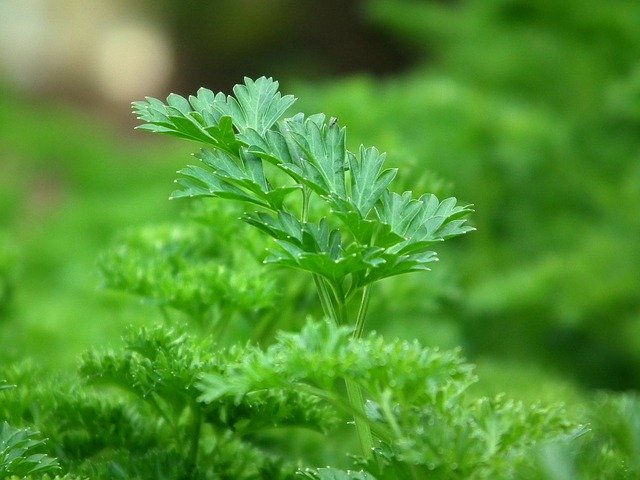Parsley Leaf

Also known as
Petroselinum crispum, Common Parsley, Garden Parsley, Curled Parsley, Devil's Oatmeal, Petersylinge.
Introduction
While all of us know parsley as a condiment and garnish, most of us never consume its most flavorful part; the root. Parsley has been an important food for at least 3,000 years. Parsley is thought to have originated in Sardinia, or the surrounding area, and to have spread across Europe by the 15th century. There are a great many myths and folktales concerning parsley. It was said to have come from the spilled blood of Archemorus when he was eaten by serpents. It was also long associated with Persephone and the underworld, which might certainly account for the lingering superstition that it is bad luck to transplant parsley; it should always be grown directly from the seed. Also, the Greek saying "to be in need of parsley" meant that someone was extremely ill and not expected to survive. Wreaths of parsley were also worn to honor the dead.
Constituents
The root and leaves contain the same essential oil, although concentrations are greater in the root. The main components (10*30%) are myristicin, limonene and 1,3,8-p-menthatriene; minor components are mono- and sesquiterpenes. The curly varieties tend to be richer in myristicin, but contain much less essential oil) The essential oil in the "seed" (3*6% of the total weight of the fruit) is either dominated by myristicin (60 to 80%; mostly var. tuberosum and var. crispum) or by apiole (70%; mostly var. latifolium). Seed may also contain allyl tetramethoxy benzene (55 to 75% in some varieties.
Parts Used
Leaf, whole or chopped, fresh or dried; "seeds" (actually fruits); and root.
Typical Preparations
Both the leaf and root can be used as tea or tincture; usually used in cooking. Both can be manufactured into an extract.
Summary
The most common use of parsley is as an edible breath freshener. In cooking, parsley lightens the taste of garlic and the odor of fish. Parsley can be added to almost any food except sweets. Naturopathic practitioners often recommend fresh parsley as a detoxifier because of its concentrated chlorophyll.
Supplementary Information on the Medicinal Properties of Parsley
- The chlorophyll in parsleys is a great help to prevent bad breath, I guess that's the reason why it is put as garnishing to meals, so it can be use as breath freshener after meal.
- Parsley helps to stimulates urination, making it a good adjunct to any therapy for breast discomfort, kidney stones, bladder stones, gravel, urinary infections and urinary difficulties.
- It is also being use in Premenstrual discomforts and other female related problems, this could be due to the fact that Parsley's phytochemicals are mildly estrogenic. It is also rich in boron and fluoride that might help against osteoporosis.
- Parsley can also help inhibit the body's histamines, which is the reason naturopathic healers use this to treat colds and congestions.
- Parleys extract can help in the treatment of bruise mark when applied topically.
- Some of the health conditions where parsley is beneficial include kidney stones, urinary problems, bad breath, poor lactation, frigidity, hair loss, heart problems, respiratory problems, arthritic pain, infection, high blood pressure, jaundice, liver Disease, skin problems, stomachache and even tumors.
Directions for use: Chew on a sprig of two after meal. You can also put 1 to 2 teaspoon of dried parsley leaves or roots in a cup of hot water daily, or ½ to 1 teaspoon of parsley extract three times a day, 2 to 4 tablespoons of fresh herb daily, or ½ to 1 teaspoon of root extract daily.
Precautions
Parsley root salad, very popular in German and Scandinavian cuisine, can increase risk of sunburn if eaten by fair-skinned person who take ACE inhibitors for high blood pressure. Parsley leaf and parsley seed do not have this effect.
For educational purposes only This information has not been evaluated by the Food and Drug Administration. This information is not intended to diagnose, treat, cure, or prevent any disease.
Except for the supplemental section, this information courtesy of MOUNTAIN ROSE HERBS, with full, written permission for reuse. For further traditional information concerning PARSLEY , please visit this excellent resource from Botanical.com. Used with full, written permission.






